Persian Cuisine or Iranian Food is one of the world’s finest. The foundation of most Persian dishes is rice, meat, and salad, often served with a side of fresh herbs, cheese and yogurt. While traveling to Iran, you will be welcomed by a wide range of delicious delights including some of the most popular Iranian dishes such as Kebabs, Caviar, Pickles, Smoked fish, Sambooseh, Falafel, Shrimp, Ash. Saffron ice cream which blink at you!
Just take a look at the vast map and geography of Iran, you will find out where the origin of this unique variety is! The existence of several different climates adds to the variety of Iranian cuisine. In addition, the Achaemenid and Persian Empire once encompassed the entire territory of the present state of Iran and its neighboring countries, and day by day more lands were seized. Also the great and important Silk Road passed through Iran, as a result many other people from different nationalities passed through this country. Together, these facts have influenced Iranians to create a rich and unique food culture.
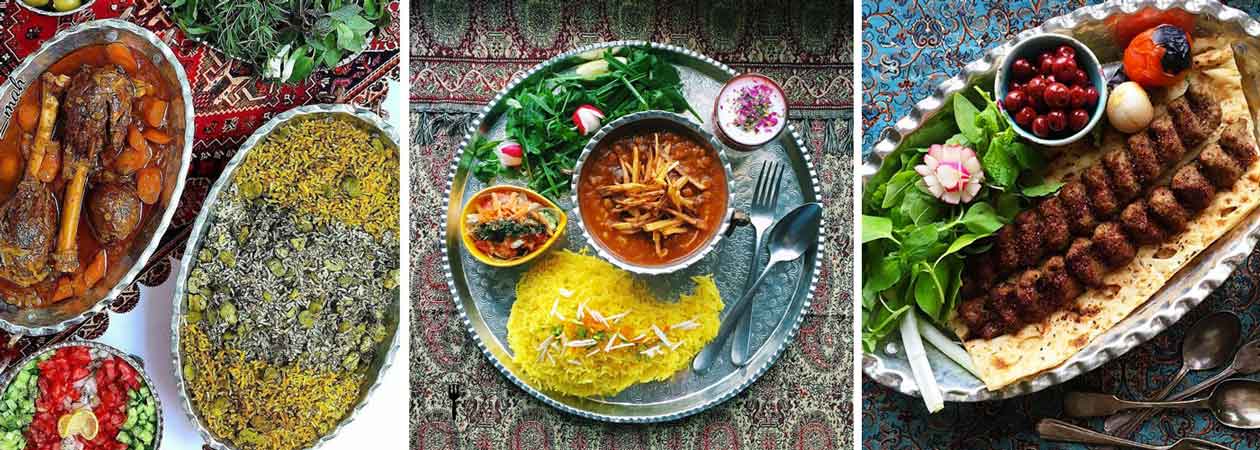
10 most common used ingredients in Persian Cuisine
- Rice
- Lamb
- Meat
- Onions
- Turmeric
- Saffron
- Dill
- Parsley
- Yogurt
- Mint
- Lentils
Of these, the most important element is arguably rice called Polow or Chelo in Farsi. It is believed that rice was brought to Iran from the Indian subcontinent, about 4000 years ago
Varieties of rice in Persian cuisine are mainly produced in the Caspian region. Basmati rice from India and Pakistan is very similar to these Persian varieties and is also available in Iran – of course cheaper! The varieties of rice most valued in Persian cuisine are prized for their aroma and typically judged by their shape, size and flavor. A Saffron infusion can be poured over the rice to give a distinctive golden color and taste. The second important thing in Persian cuisine is Kebab. Different types of kebabs can be found in almost all restaurants but don’t expect non-Halal types of meat like pork that Islam forbids. They’re not available in Iranian restaurants.
Halal food in Persian Cuisine
According to Iranian regulations, only halal food is offered in Iran. Halal food is not served with alcoholic beverages. The meat and chicken that is to be used for cooking is slaughtered in a special Islamic way. Also meat of some animals such as pork, dogs, mice, etc. are not used in Iran because of being not Halal.
Under Iranian law, carrying and use of alcohol and drugs, including Marie Joanna, is prohibited in public places, and there is no official place to serve them.
Famous Iranian Dishes
Today, food is a big deal for Iranians. Family gatherings often involve multiple hot and cold dishes, never-ending amounts of rice (!) and plenty of encouragement to keep eating more. The origins of Persian cuisine is a bit complex – due to Iranian history of over 2,000 years. the Persian Empire once stretched from India to Greece, since then, Iranian cuisine has been influences by various nations throughout the vast empire. Neighbors such as Greeks, Romans, Arabs, Russians and Turks also influenced it.
Are you Keen to try the basics of Persian (Iranian) cuisine? We take you through some of the most popular dishes of Iran:
1Fesenjan stew
Fesenjan is a symbolic and integral part of Persian cuisine at wedding ceremonies and ceremonial parties – a delightful blend of pomegranate paste and chicken or duck meat.
Onions, walnuts and chicken are slowly cooked together with pomegranate paste to produce a thick dark brown sauce. Saffron and cinnamon are sometimes used to flavor the dish, and sometimes they add a little sugar to balance the taste.
It is interesting to know that Fesanjan Stew has a long history. Archaeologists have found inscriptions in the remains of Persepolis, the ancient capital of the Achaemenid Empire, some of which were related to the raw materials of the Empire’s kitchen. One of these inscriptions shows pomegranates, poultry meat and walnuts, all of which are the three main ingredients in Fesenjan stew
2
Khoresh Bademjan (Eggplant stew)
A red and golden eggplant stew cooked with tomatoes and turmeric is one of the most popular Iranian dishes. First of all, you can taste a bit sour and sharp with tomato juice, lemon juice and sometimes verjuice taste.
This stew is made with fried eggplants and beef in a tomato based sauce. To cook the eggplants, first fry them in the oil or grill and then cook with lamb, onions, tomatoes, water and spices. Eggplant is thick like all Iranian stews and usually served over Persian rice or with a special Persian bread called Lavash, but you can serve it with pita bread or crackers too.
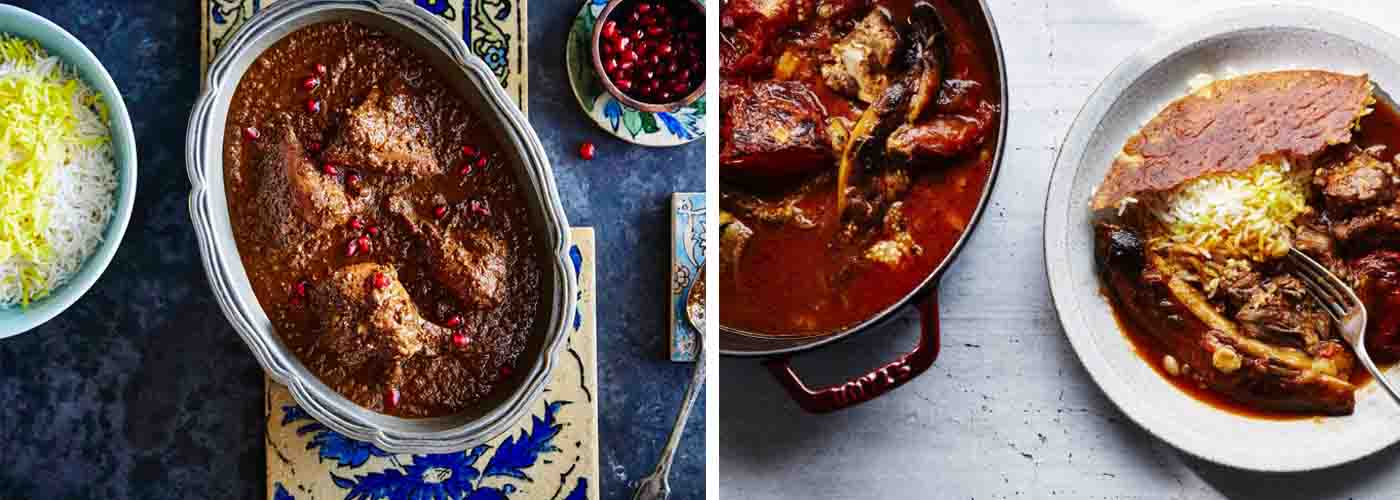 Left: Fesenjan Stew Right: Eggplant Stew
Left: Fesenjan Stew Right: Eggplant Stew
3
Baghala Polow (Fava Bean Rice)
In Iranian cuisine, they often cook rice with butter and saffron, which is then called “Chelo“. But sometimes they cook rice with other ingredients such as beans, vegetables, nuts, fruits, meat and call it Polow. One of the varieties of rice is the Baghala Polow which is very popular in the spring season, as the Fava beans (Baghala) are fresh and very good for cooking.
If you are served with a dish of Baghala Polo, the green color will be the first notable thing. This dish is usually served with lamb meat, lamb shank, and sometimes with roasted or cooked chicken. A good Baghala Polo is always accompanied by a soft fragrance of saffron!
4
Zereshk Polo (Barberry Rice)
Iranians love sweet & sour or strong sour flavors, so it is not surprising that cranberries and barberry are listed among the raw ingredients of Iranian cuisine. Other raw materials used for Iranian sour dishes and soups include green plum, rhubarb, bitter orange, fresh lemon, dried lemon, tamarind, cherry, sumac and pomegranate.
Barberry Polow, this Persian classic dish, is packed with red barberries (Zereshk) that have been dried before fried. Rice (Polow) is cooked with lots of butter to help soften and flavor the barberry. The chicken (Morgh) is the main component of this recipe and it is cooked separately in a tomato saffron sauce, so it is easy to make in large amounts; the same goes for the rice.
This is one of the mixed rice dishes that you will find everywhere in Iranian restaurants as well as weddings and most festive celebrations.
What is Saffron?
5
Ghormeh Sabzi (Vegetable stew)
Vegetable Stew (Ghormeh Sabzi) is one of the most delectable and popular Iranian dishes that almost every Iranian loves. This stew is a mixture of aromatic vegetables such as parsley, leeks and coriander cooked with red beans and lamb. In addition, sour flavor would be supplied by Omani lemon (Dried Lemon). One of the unique flavors comes from fenugreek which is a new and unfamiliar taste for many westerners.
The secret to a delicious Iranian vegetable Stew is the time it takes to cook slowly on a low flame.
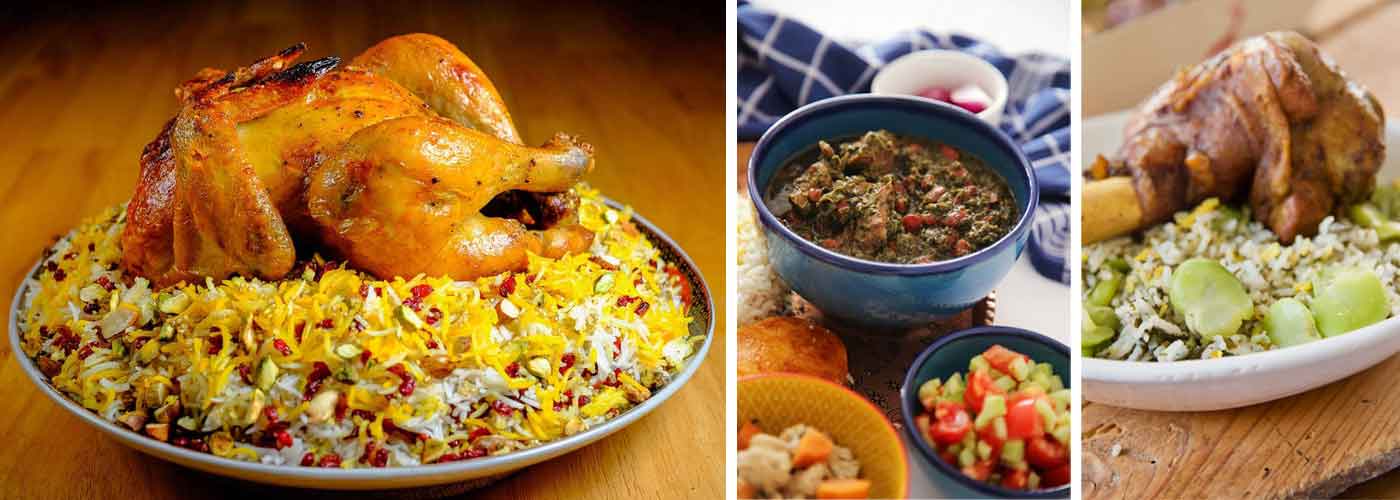
Left: Zereshk Polo Morgh | Middle: Ghormeh Sabzi | Right: Baghala Polo with lamb Shank
6
Aash Reshteh (Noodle & Vegetable Soup)
Aash Reshteh is a kind of thick soup with a dense texture of Noodles. It is a delicious blend of beans, herbs and leafy vegetables such as spinach and Swiss chard. Before serving, they are topped with fried onions, fried mint and curd. Curd is similar to concentrated buttermilk produced in Central Asia. To make the onion and mint dressing, just fry them in the hot oil separately and put them on top of the dish before you serve it. It is interesting to know that the special noodle used in this dish has come a long way from eastern Asian cultures and has reached Iran, which in Iranian culture is a symbol for different ways of life.
Ash Reshteh has long been associated with Iranian culture and life. In the past, Iranian families cooked this soup in occasion of a family member’s long journey, to symbolize the goodwill and good wishes for the traveler. On the other hand, because of the nutritional value of used raw materials that are considered auspicious in the Iranian culture, people also cook Ash Reshteh in occasion of Nowruz and New Year’s Eve.
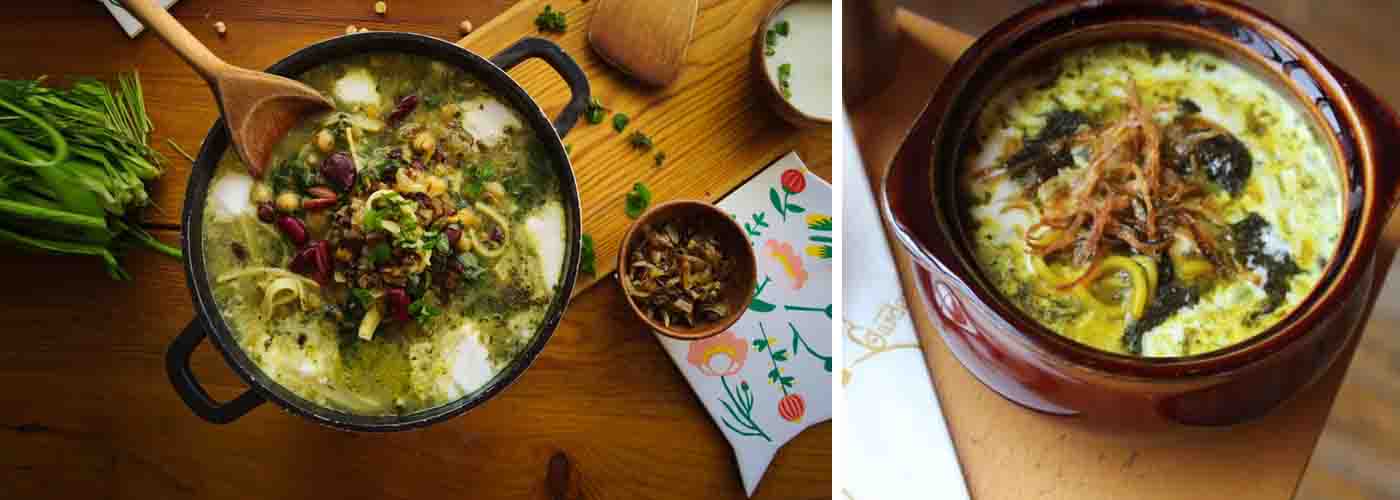 Ash Reshteh, Iranian Vegetable& Noddles Soup
Ash Reshteh, Iranian Vegetable& Noddles Soup
7
Tah Dig (Rice Crisp)
Undoubtedly Tah Dig is the soul of Iranian cuisine! It is a crispy, greasy golden layer of rice that is fried on the bottom of the pot and has a similar taste to pop-corn and potato crisps.
Tah Dig meaning (the bottom of the pot), this delicious, golden portion never comes on the menu of restaurants, and if you want it, you should ask them. Some restaurants, though, offer their own Tah Dig as a fancy side dish. Rice Crisp is one of the most popular parts of the food, particularly for children.
Tah-dig, the crispy bottom of the rice 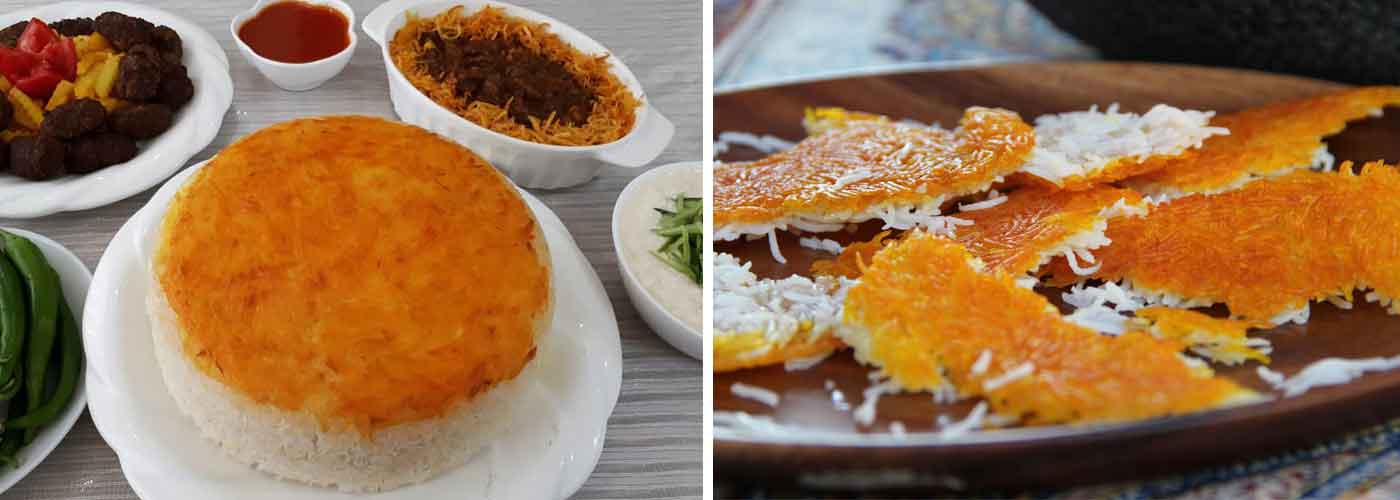
8
Kebabs (Lamb, Beef, Chicken)
Iranian kebabs are more diverse than you might think. First of all, go for Minced Kebab, which is made of red meat, chopped onions, salt and pepper. It may sound simple, but its taste is unique. Then there’s the Barg Kebab, which is thin slices of lamb or beef, marinated in lemon juice, onions, saffron and butter. Chicken Kabab or “Jujeh Kabab” are usually roasted on fire after marinating chicken in lemon juice, onions and saffron. You’d better order it on bone.
If you are lucky enough, you can also find a “Jigaraki” shop and enjoy a liver Kebab with fresh basil and Lavash bread.
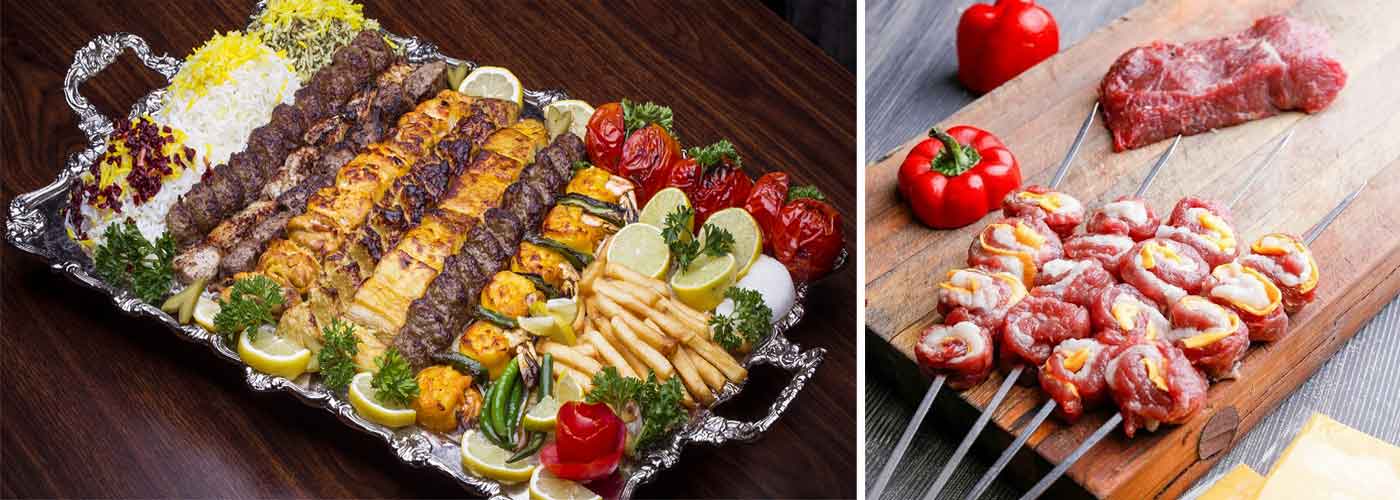 Iranian Kebabs
Iranian Kebabs
9
Tahchin – e Morgh (The Iranian Rice Cake)
Tahchin, also written Tah-chin is a glorious savoury rice cake from Iran consisting of rice, chicken, yogurt, saffron, and eggs. Some versions of Tah-chin are more elaborate, mixed with nuts such as almonds, also barbberies. The name refers to the layering of chicken and rice, which is then baked until it has a crisp base, called Tah-dig. It’s best to use a nonstick pan in an oven, because it helps in getting that crisp, and golden exterior. Tahchin is composed of two different parts: the thin and crispy Tah-dig part and the soft rice mixed with the chicken fillets, saffron, and other ingredients.
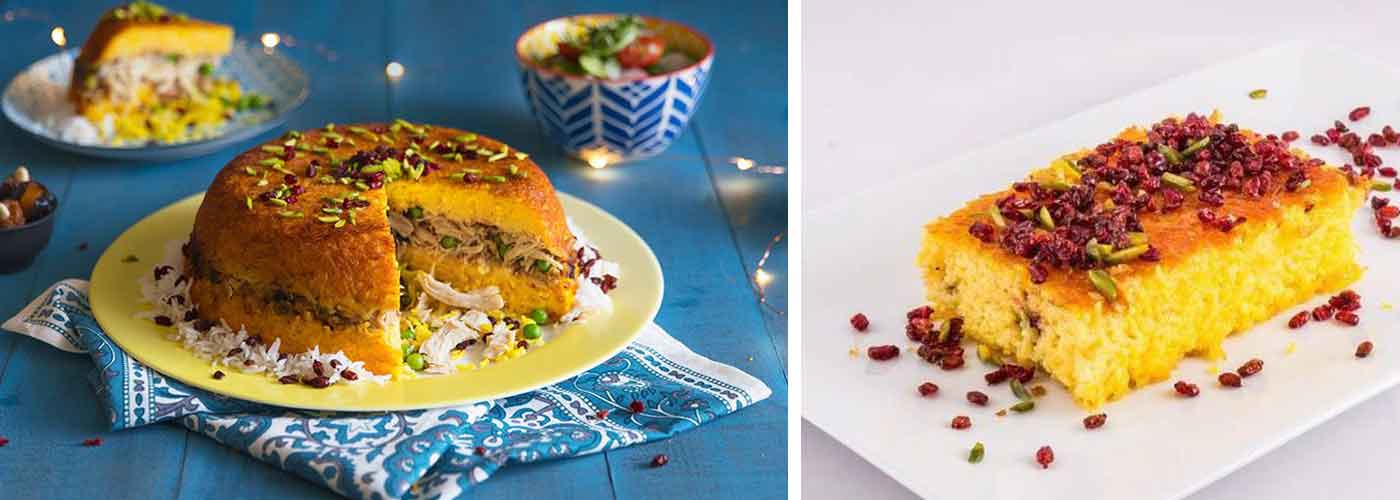 Tah-chin, Iranian rice cake
Tah-chin, Iranian rice cake
10
Dizi
Also known as “Abgoosht” which literally means “meat broth” is essentially a stew made up of lamb and chickpeas with a tomato base. It is traditionally served in a stone dish called a dizi – from which the name of dish comes from. Iranian traditional restaurants still use these stone dishes for this food.
Dizi dates back to hundreds of years ago.This high-calorie food, which is a good source of protein, is more common and preferred in winter. It would be originally made with lamb and chickpeas only before tomatoes and potatoes were introduced to Iranian cuisine and developed the recipe.
Meat and beans are the major ingredients of Dizi, but in some areas locals may add different things to the recipe based on their tastes. For example, in northern parts of Iran, garlic, and in Kerman province, people may add caraway for seasoning.
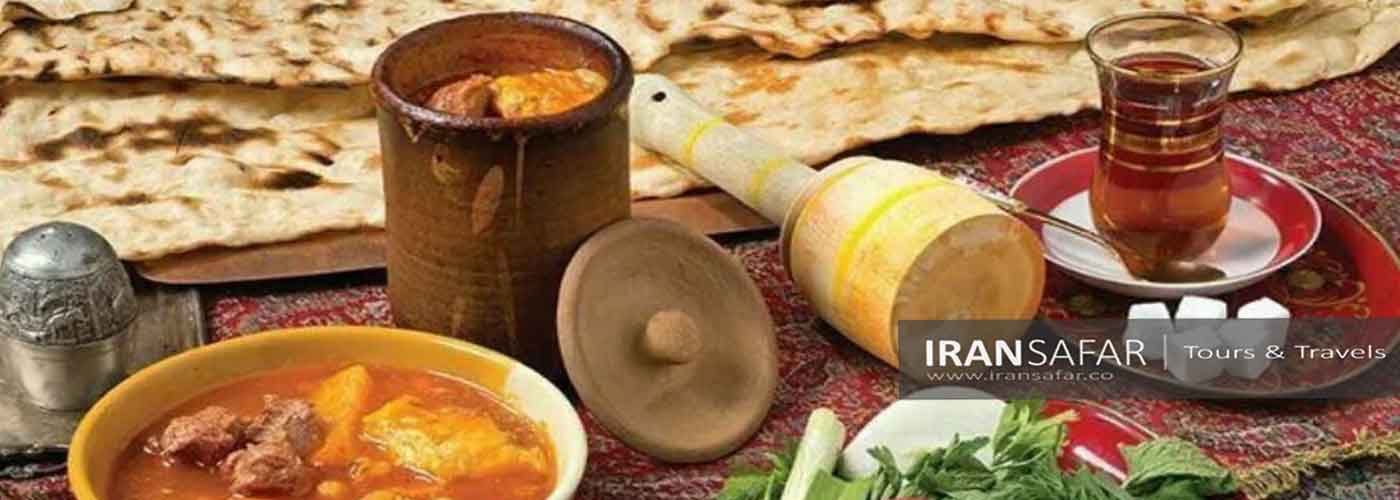 Dizi, Iranian Traditional Cuisine
Dizi, Iranian Traditional Cuisine
Table manners in Persian Cuisine
Unlike European food culture, most traditional Iranian dishes do not need a knife to be served. In most cases, you can easily eat with a spoon and fork. Some foods only need a spoon to use. Others are wrapped in bread and eaten by hand. To learn more about Iranian food culture, see here.
What spices are in Iranian food?
The aroma and flavor of spices, along with their amazing properties and benefits, has made people of different regions of Iran use a special combination of spices in preparing their food. These spices are based on the geographical and climatic characteristics and body temperament of the inhabitants of each region. Iranians believe that spices not only add flavor to your food but also bring you many other benefits. Some have protective properties against cancer, diabetes, heart disease, inflammation and so on. Here are 11 healthy Iranian spices and their amazing benefits plus tips on how adding them to your diet.
10 most popular Iranian spices used in Persian cuisine are: Turmeric, Saffron, Sumac, Cinnamon, Cardamom, Fennel seeds, Chili powder, Black pepper, Coriander seeds, Cumin
Breads in the Cuisine of Iran
Due to agricultural background of Iranian nation and indivisible relationship between bread and Iranian lifestyle, bread baking has a long history in Iran. Today, an increasingly wide variety of this healthy and nutritious food is prepared and consumed throughout the country. At the end of this article, we try to provide some information about main types of breads used in Iranian cuisine.
In addition to numerous historical sights in Iran, when you travel to Iran you will understand the diversity of cuisine in the country. Not only the type of dishes, but also sweets, pickles, pastry, and bread!
There are dozens of different types of local breads in every village and the city around the country but four main types of Persian bread are most popular and widely used by people. They are Barbari, Sangak, Taftoon, and Lavash breads.

Barbari Bread
The word “Barbari” means related to Barbars or Barbarians, and term Barbar stands for a group of people who lived near the current border pf Iran and Afghanistan. The bread got its name since the bread was originally baked in that area and gradually routed into different regions of Iran.
Barbari bread is tick and flat (sometimes round) with about 50 cm long and 20 cm wide. It is usually baked plain or with sesame topping.
Sangak Bread
Sangak means pebble or gravel stone. It got its name from the special oven which is a bed of gravel stone with fire on top. Sangak is a plain, flat and almost triangular whole wheat bread. Some bakeries apply different types of toppings such as sesame, dried herbs, and caraway.
In Iran, it’s very popular to eat Kebabs, and Dizi with Sangak. This bread is also popular in Azerbaijan.
Taftoon
Taftoon, Taftan, or Taftun is a Persian term which is derived from “tafidan” which stands for “heating”. This bread is baked in all cities of Iran and is one of the most popular breads among Iranians. This fragrant and delicious bread can be consumed with various foods. Taftoon is also baked in other countries such as Afghanistan, Pakistan and India, and it is interesting that bread is taken from it in Shahnameh book. According to Shahnameh “Taftoon” has been baked and used by people for centuries. The traditional way of baking the bread was baking in a clay oven called tanour in Farsi. In the past, women baked Taftoon bread in the villages, and today some Taftoon bakers in villages are still women. Taftoon baking tools and equipment with the slight differences are left in the same old rural form. Today, urban bakers use more or less the same tools as village bakers.
Lavash Bread
Lavash Bread is round and the thinnest bread among all different types of bread in Iran. This bread is also one of the most common types of bread in Armenia, Azerbaijan, and Turkey.
In 2014 Lavash Bread, the preparation, and meaning was listed as Intangible Cultural Heritage of Humanity of UNESCO from Armenia. However, after two years, in 2016, the countries of Azerbaijan, Iran, Kazakhstan, Kyrgyzstan, and Turkey were also added to the list of representative.
Iranian Bread Oven
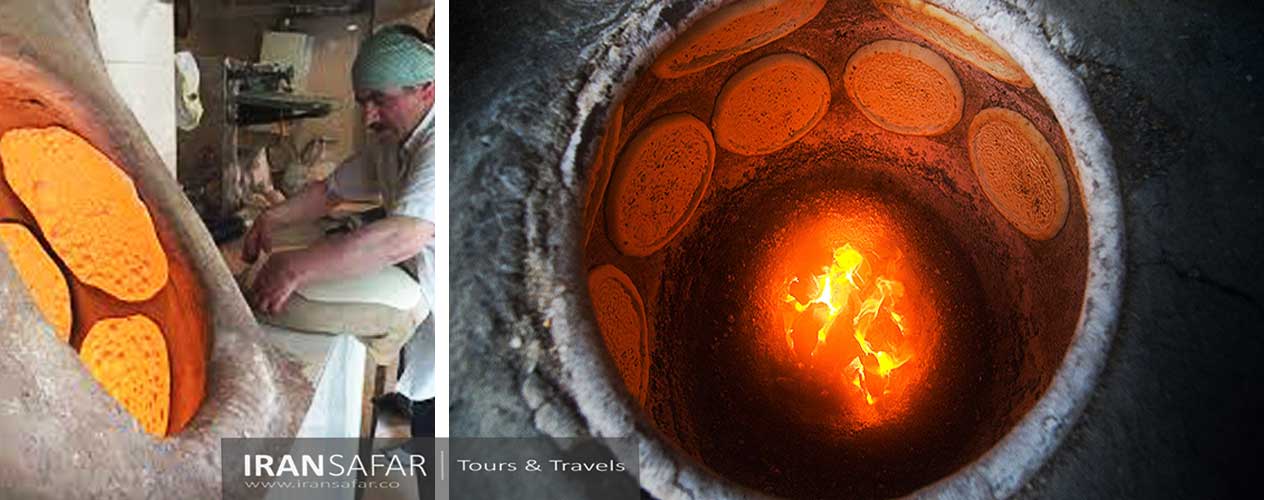
A tanour or tandoor is a cylindrical clay or metal oven used for cooking and baking. Traditional tanours can be found in Southern, Central, and Western Asia, as well as in the South Caucasus.





Comment (0)